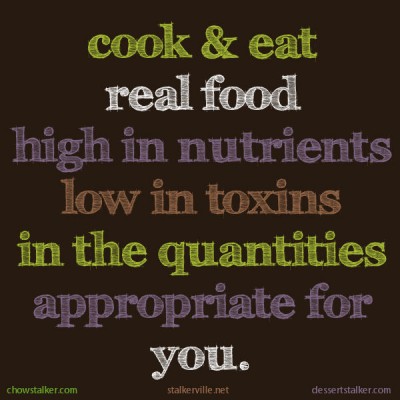Paleo is sometimes described as the caveman diet, ancestral eating, primal, etc. But what it boils down to is eating real food that does your body good and the following principles are common ground for most versions of paleo:
- Quality matters. Consume a wide variety of well-raised (grass-fed, pastured, wild) animal protein and an even wider variety of vegetables. Include some nuts, seeds, fruit and starches as needed.
- Avoid gluten, most grains, vegetable oils, and legumes. Keep sugar intake low, regardless of the source, but especially from highly processed sugars and sweeteners.
- Cook! Opening cans or popping a cardboard box in the microwave isn’t cooking. Don’t eat things with long lists of unrecognizable and artificial ingredients. Really cook using single ingredient foods.
- Explore local food sources. Shop at farmer’s market and connect with local farmers. And grow some of your own food.
- Paleo is not a religion, so unless you’re in the midst of a Whole30 or 21 Day Sugar Detox or have a health issue, you don’t have to be perfect all the time. Relax and enjoy life! Sometimes, as the Chinese and Chris Kresser point out, it is more appropriate to eat the wrong food with the right attitude than the right food with the wrong attitude. If you are breaking out into a sweat trying to resist Aunt Mary’s famous Thanksgiving Apple Pie, have a small slice. Just one.

If you’re new to paleo and our site, here’s a brief run-down of the most popular “flavors” of paleo and how we use them on this site:
Primal
Many people, including us, stumble on to paleo via Mark’s Daily Apple and The Primal Blueprint created by Mark Sisson. Generally “primal” refers to a paleo diet that allows some dairy but the focus is still on eating high quality protein, lots of vegetables and high quality fats. When dairy is part of a paleo diet, it’s best to find a source for the raw, grass-fed variety. If you can find it, try dairy products from goats and sheep as well.
Whole 30
“Suck it up Butter Cup!” The Whole 30 program from Dallas and Melissa Hartwig is a tough-love approach to “help you restore a healthy metabolism, heal your digestive tract, calm systemic inflammation and put an end to unhealthy cravings, habits, and relationships with food.” If you’re sick and tired of being sick and tired, then this may be exactly the program to kick start your journey to better health.
21DSD
The 21 Day Sugar Detox was developed by Dianne Sanfiilippo of Balanced Bites to help people kick their sugar addition and eases folks into cleaner eating. This program is outlined in the 21 Day Sugar Dextox ebook and will soon be available in print.
Gluten-free
All versions of paleo and all of the recipes on our sites are free of the gluten containing gains – wheat, barley and rye – the 3 biggest triggers for autoimmune symptoms. However we do publish recipes that may include sauces, such as soy, which can contain gluten. Be sure to check recipes and labels of included products carefully. BTW, many “gluten-free” products are still full of shady products and they are not featured on this site.
Grain-free
Most of the recipes on our site are grain-free as well. The only grains that make the cut are white rice and organic corn. Please see our description of the Perfect Health Diet below and our FAQs for our reasons for making exceptions to this rule.
The Perfect Health Diet
This diet differs from the typical paleo diet by including “safe starches” in the form of white rice, taro, sago, plantains, sweet potatoes, potatoes and tapioca. “The Perfect Health Diet” was created by Paul and Shou-Ching Jaminet, both PHDs, who cured their own chronic health issues by changing the way they eat. Check their website or their book for more details
The Auto-immune protocol
Recipes in the autoimmune protocol (AIP) category are strict paleo minus eggs, nuts, seeds (including coffee and cocoa), dairy and nightshades (potatoes, tomatoes, peppers, eggplants and red pepper spices including paprika). AIP is very nutrient dense and removes foods that contribute to a leaky gut which is strongly associated with autoimmune disease. Eileen Laird is our Auto Immune Ambassador and she insures that every recipe in the AIP category meets this criteria.
Low FODMAP
A low FODMAP diet is recommended for those suffering from IBS due to malabsorption of “rapidly fermentable carbohydrates” such as fructose. Following a paleo diet eliminates many of the foods high in FODMAPS, such as wheat, most grains, legumes, and sugar. However many paleo-friendly foods are also high in FODMAPs such as Alliums (onions, garlic, shallots, leeks) and Brassicas (cabbage, cauliflower, broccoli, Brussels sprouts). Other paleo vegetable favorites that can be problematic are artichokes, asparagus, avocados, beets, fennel, mushrooms, okra and young peas such as sugar and snow peas. Fruits that are high in FODMAPs are apples, apricots, mangoes, cherries pears, peaches, plums, watermelon and any dried fruits. Concentrated tomato products, honey and most dairy should also be avoided when trying to minimize FODMAP consumption.
Nightshade free
Nightshades are a family of plants that include potatoes, tomatoes, tomatillos, peppers, and eggplants. The level of alkaloids in these common foods is generally safe for many people (unlike deadly nightshade which really is deadly) but still high enough to cause inflammation, especially for people with autoimmune conditions. Unfortunately, some of the most popular spice blends, such as curries, are made with nightshades.
We have thousands of recipe submissions from hundreds of paleo home cooks, chefs and cookbook authors, including most of the ones listed above. So as hard as some of these paleo protocols may sound at first, you’ll find plenty of support and recipes here to help you stay on track with your own version of paleo!





